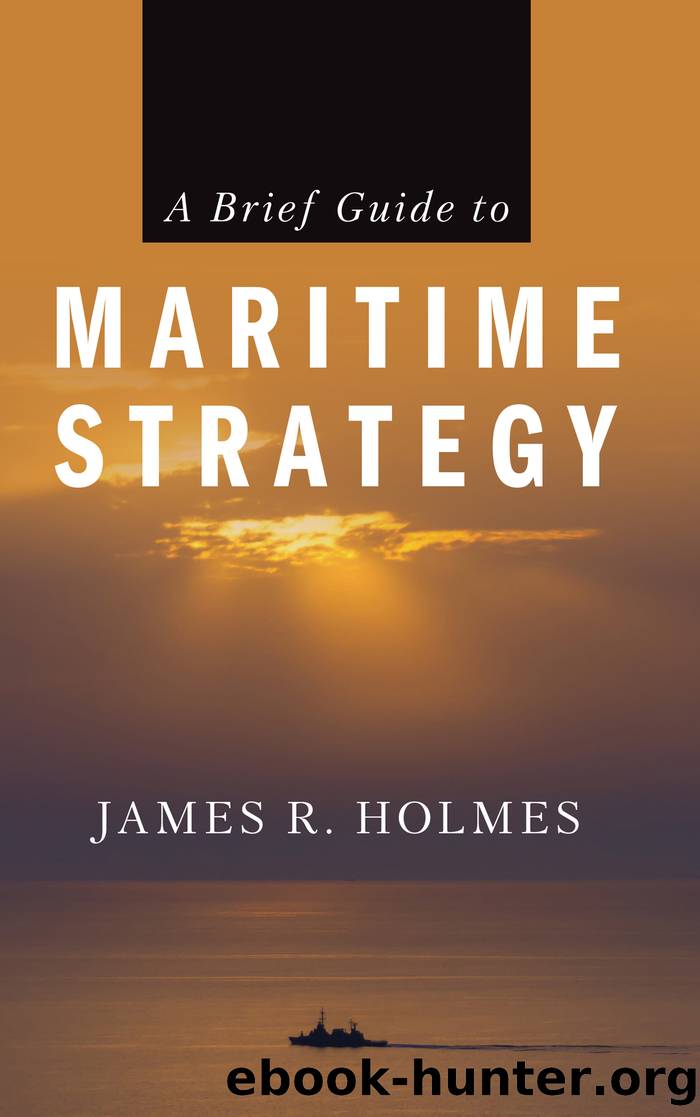A Brief Guide to Maritime Strategy by James R. Holmes;

Author:James R. Holmes;
Language: eng
Format: epub
Publisher: Lightning Source Inc. (Tier 3)
Published: 2019-05-15T00:00:00+00:00
Chapter 3
What Navies Do
From the makings and rhythms of sea power we now turn to the practical side of how navies further the operational, strategic, and political aims entrusted to them. A force fulfills its mission by doing the things familiar to all mariners, such as drawing up and administering shipbuilding programs and operating and overhauling equipment. Naval leaders must also tend to the human factor in naval warfare. U.S. Air Force colonel John Boyd reminds posterity: people, ideas, and hardwareâin that orderâare the chief determinants of success and failure in human competition.1 To invigorate the human factor, the leadership must mold a culture that fits the strategic and operational surroundings and keeps pace as those surroundings change around the service.
As they will. Renaissance Florentine philosopher-statesman Niccolò Machiavelli makes this point forcefully, portraying founding a new state or institution as the most formidable act of statecraft.2 Adjusting the culture of that state or institution amid fluid times comes next in importance and difficultyâespecially if the institution has grown corrupt and needs to be purified. Stasis kills. And yet human beings and their institutions dislike change. They find it an ordeal.3 Machiavelli contends in effect that nature has hardwired individuals to continue doing what worked in the past until harsh experience compels them to do otherwise. Fortune varies, but they remain set in their ways. Sailors are fond of the old saw âif it ainât broke, donât fix it.â The saying conveys an essential Machiavellian truthâthat few people reform old ways until reality proves the old ways are âbroke,â and proves it in unequivocal fashion.
As it is with individuals, so it is with organizations, which after all are bodies made up of individuals to whom philosophersâ wisdom applies. Institutions discharge their functions through standard methods, yet the world refuses to stand still to accommodate their preference for routine. This clash between human nature and mercurial surroundings forces leaders to amend standard operating procedures or court disaster. Ruin follows when they fail to break shopworn patterns of thought and deed. Leaders throughout the institutional hierarchy, then, must take charge of their corporate destinyâand undertake constant cultural renovation to thrive.
Download
This site does not store any files on its server. We only index and link to content provided by other sites. Please contact the content providers to delete copyright contents if any and email us, we'll remove relevant links or contents immediately.
The Radium Girls by Kate Moore(11584)
100 Deadly Skills by Clint Emerson(4661)
The Templars by Dan Jones(4546)
Rise and Kill First by Ronen Bergman(4536)
The Doomsday Machine by Daniel Ellsberg(4233)
The Rape of Nanking by Iris Chang(4003)
Killing England by Bill O'Reilly(3889)
Hitler in Los Angeles by Steven J. Ross(3786)
Stalin by Stephen Kotkin(3709)
12 Strong by Doug Stanton(3406)
Hitler's Monsters by Eric Kurlander(3142)
Blood and Sand by Alex Von Tunzelmann(3038)
Darkest Hour by Anthony McCarten(3007)
The Code Book by Simon Singh(2835)
The Art of War Visualized by Jessica Hagy(2820)
Hitler's Flying Saucers: A Guide to German Flying Discs of the Second World War by Stevens Henry(2615)
Babylon's Ark by Lawrence Anthony(2420)
The Second World Wars by Victor Davis Hanson(2413)
Tobruk by Peter Fitzsimons(2366)
